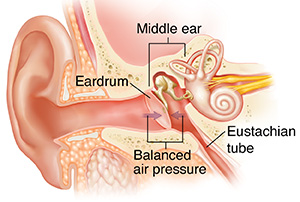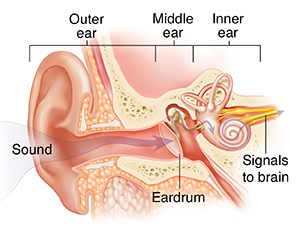The Middle Ear
The middle ear is an air-filled chamber that lies behind the eardrum. Pressure in the middle ear changes to match air pressure outside of the eardrum. When inside and outside pressures are balanced, the eardrum is flexible and normal hearing is more likely. Problems happen when air pressure in the middle ear drops. This is often due to a block in the eustachian (yoo-STAY-shuhn) tube, the narrow channel connecting the ear with the back of the throat.
An open tube
As the link between the middle ear and the throat, the eustachian tube has two roles. It helps drain normal, cleansing moisture from the middle ear. It also controls air pressure inside the middle ear chamber. When you swallow, the eustachian tube opens. This balances the air pressure in the middle ear with the pressure outside the eardrum. In infants and young children, the eustachian tube is short and almost level with the ear canal. By about age 7, though, the eustachian tube has become longer and steeper. This improves how well it works.

Normal hearing
The eardrum and middle ear are vital for normal hearing. Together, they pass sound from the outer to the inner ear. When sound from the outer ear hits a flexible eardrum, the eardrum vibrates. The small bones in the middle ear pick up these vibrations and pass them along to the inner ear. There, the vibrations become electrical signals, which are sent along nerve pathways to the brain.

Online Medical Reviewer:
Daphne Pierce-Smith RN MSN
Online Medical Reviewer:
Marianne Fraser MSN RN
Date Last Reviewed:
4/1/2025
© 2000-2025 The StayWell Company, LLC. All rights reserved. This information is not intended as a substitute for professional medical care. Always follow your healthcare professional's instructions.